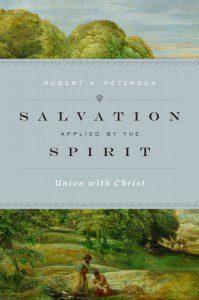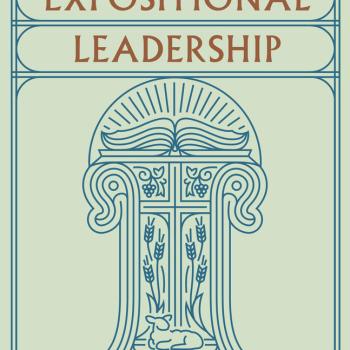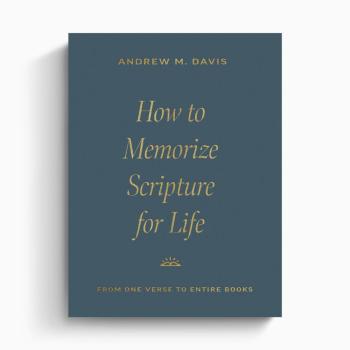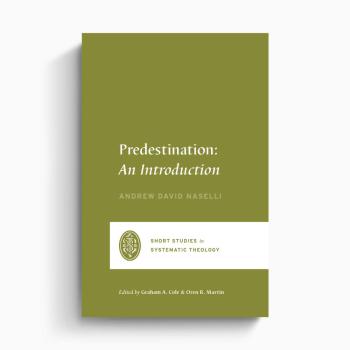Review of Salvation Applied by the Spirit: Union with Christ by Robert A. Peterson
Robert Peterson’s Salvation Applied by the Spirit is the second installment of a planned trilogy. The first, Salvation Accomplished by the Son: The Work of Christ, was released in 2011 and was well-received as a long and nearly exhaustive treatment of the redemptive acts of Jesus Christ. This second volume is no less ambitious and will serve as a useful reference for pastors and scholars alike.
Salvation Applied by the Spirit comes at a time of renewed interest in the doctrine of union with Christ among evangelical communities in the United States. Over the last few years, significant books have been published on the topic, approaching it from different disciplines. Robert Letham’s Union with Christ: In Scripture, History, and Theology is a historical theological take while J. Todd Billings wrote Union with Christ: Reframing Theology and Ministry as a systematic theology with ministry relevance. Perhaps the most well-known and definitive work to come out in recent years was Constantine Campbell’s Paul and Union with Christ: An Exegetical and Theological Study that intensively indexed and investigated Pauline texts dealing with the doctrine of union.
Peterson divides his study into two parts. First, he examines each verse in Scripture that speaks of union; and second, Peterson develops a theology of union. This bifurcation of the book makes it a bit disjointed, allowing us to read the two parts separately without a problem. Readers only interested in the theological development of union can skip to the second part, bypassing the verse-by-verse treatment in part one. Peterson could arguably have tried to integrate the two parts better, but the division makes Salvation Applied by the Spirit useful as also a reference tool. On the other hand, he spends about 250 pages working through each scripture passage, which may be redundant in terms of scholarship since Campbell has already done much the same thing in Paul and Union with Christ. In fact, while Peterson’s footnotes do refer to a variety of commentaries, Campbell is cited repeatedly.
Union with Christ in Scripture
In part one, “Union with Christ in Scripture,” Peterson refers to the “union verses” in the Old Testament, the synoptic gospels, and Acts as “foundations” because they do not directly address union but rather form the backdrop for the doctrine. He organizes the foundations around three concepts: identification, incorporation, and participation. This is perhaps the most interesting, though shortest, segment of Salvation Applied by the Spirit. And the organizing concepts are again taken from Campbell. Nonetheless, it is interesting to trace union throughout the scriptures even when not systematically explained. For example, Jesus in the synoptics is identified as the Messiah and the true Israel. And Christians participate in Christ’s suffering in Acts.
The bulk of the verses referring to union with Christ are in the gospel of John and the Pauline epistles. The most prevalent Pauline theme of union is “in Christ” language. Anyone familiar with Paul’s letters will undoubtedly know the phrase. Peterson distinguishes between a broad sense and a narrow sense of “in Christ.” Unfortunately, Peterson only refers to this framework in a chapter summarizing union with Christ in Paul’s letters, after he has gone through verse after verse of Paul’s epistles. Without this clear distinction to guide readers, what exactly union entails gets lost amidst the spectrum of usages.
The broader sense refer to personal relatedness to Christ in addition to additional meanings; he lists agency (God accomplishes many things through Christ); association (under Christ’s influence); cause (people do things because of Christ’s person and work); instrument (God accomplishes by means of Christ); manner (the manner in which something should be done); object of faith; periphrasis for “Christian”; and realm, sphere, or domain (locative).
The narrow sense refers to union with Christ being the means of God’s saving purposes–what we traditionally mean by “union.” Peterson follows Campbell’s lead in identifying seven passages directly referring to union with Christ: 1 Corinthians 1:30-31; 2 Corinthians 5:21; 2 Corinthians 13:3-6; Ephesians 1:7-10; Ephesians 6:10-12; Philippians 3:8-11; and Colossians 2:9-10. He does point out, however, that Campbell missed two passages that also use the narrow sense (which Campbell has admitted is true): 1 Thessalonians 1:1 and 2 Thessalonians 1:1-2. These two passages refer to being “in” both the Father and the Son.
In addition to the “in Christ” language and being “in” the Father and the Son, Paul’s letters also include union in greetings and a strong theme of participating in Jesus’s narrative. By participating in Jesus’s narrative, Peterson means that specifically, “they die with him, are buried with him, are raised with him, ascend with him, sit down with him in heaven, and amazingly, in a sense will even come again with him” (197). The Christian’s participation in Christ’s redemptive acts are the only antidote to sin’s effects.
Peterson also draws together major pictures and themes used to describe union, including body of Christ, temple, marriage, new clothing, filled to all the fullness, and indwelling. Each has its dimensions explored. For example, when discussing systematically the use of body of Christ language, he draws attention to the role of the Holy Spirit, the corporate and vertical, the corporate and horizontal, the corporate and individual, and the organic nature of the body as it grows into Christ, the head (210-213).
Aside from the Pauline epistles, Peterson spends the second most number of pages dissecting the gospel of John and 1 John. Noteworthy is the the use of “abide in” language in the Johannine literature. The imagery of abide refers to active fellowship with the Son and the Father. His treatment of John 6 and John 15 are particularly sweet. He concludes his chapter “Union with Christ in John’s Gospel” with points of application that stand out as incredibly pastoral relative to the other chapters in part one. Reflecting on our need to “eat” and “drink” the Son of God (John 6:55-57), he concludes that “we must rely on him for spiritual sustenance.” “We must focus on the Son to learn of the invisible Father” and “[o]ur study of union with Christ must lead us not away from his person but deeper into his person” (72). Referring to Christians abiding in the Vine, “we enjoy rich fellowship with him as we walk with him in obedience. Answered prayers and joy follow” (72).
Having weighed the benefits and drawbacks of part one, I must conclude that Peterson, while exhaustive in his investigation of Scripture, does not organize his chapters enough to lead readers to any overarching conclusions until he provides it in two summary chapters on Paul’s letters, inconveniently nestled in the middle of part one. At the same time, Campbell’s Paul and Union with Christ remains the definitive exegetical study of the doctrine. Perhaps the primary benefit of Peterson’s exegesis (which comprises over half the book), is that it is conveniently located in a single volume, side-by-side with his theological study.
Union with Christ in Theology
Part two of Salvation Applied by the Spirit starts with a run-through of how union is integral to the biblical metanarrative: eternity past, creation, the fall, the incarnation, Christ’s work, and the new creation. Peterson dedicates three chapters to the Holy Spirit’s, only one of which tackles the issue of the Spirit’s work in uniting believers to Christ. He uses one chapter describing the Spirit’s personality and establishing divine status. Then Peterson outlines the works of the Spirit other than union with Christ, including the Spirit’s work in creation, Scripture, the world, the apostles, and Jesus.
The final chapter specifically dedicated to the Holy Spirit, in what one can only assume is the crux chapter of the book (“The Most Important Work of the Holy Spirit”), only runs 28 pages. This most important work is applying salvation to believers. Union forms the large set, whereas soteriological elements such as regeneration, justification, adoption, sanctification, preservation, and glorification, comprise subsets.
The concluding chapters are a repetitious read, given that many of its key points have already been covered in prior chapters, particularly the two summaries of union in Paul’s letters. There is a chapter on christology (“The Christ to Whom We are United”), which seems redundant given Peterson’s first installment Salvation Accomplished by the Son. A chapter on ecclesiology (“Union with Christ in the Church”) will also seem familiar to readers because it covers old ground: living temple, abiding in the Father and the Son, being “in Christ,” participating in Jesus’s story, the body of Christ, and the bride of Christ. These aspects of union have already been covered, but this time around the church is included. No doubt the church is an under-appreciated doctrine in many theologies, but the cut-and-paste feel of the chapter makes for stale reading. The final two chapters are on the sacraments and the Christian life.
Salvation Applied by the Spirit very much reads like a patchwork of different ideas and themes. Nothing really holds it together. One assumes by the title that the Holy Spirit’s role in soteriology would be the common thread, but as explained above, Peterson’s treatment of this is limited to one chapter (three if you want to be generous). Another “patchwork” symptom is the way each chapter in part two reads like a string of quotes from different scholars, padded by descriptive paragraphs. Individual chapters rely heavily on a handful of authors. For example, in “Union with Christ and the Biblical Story,” Peterson makes repetitious use of Philip Hughes’s The True Image and Robert Letham’s Union with Christ, not only citing them frequently, but also including many block quotes. This is not inherently a problem, yet one would think such an important theological concept as imago Dei would have several works worthy of citation and interaction. And the sheer number of block quotes is staggering!
Peterson’s use of quotes can be tedious. Many of them appear unnecessary, where a paraphrase would do just fine. For example, “Gordon Fee shows that the Lord’s Supper is the ‘Christian version of a meal in honor of a deity,’ with Jesus as the Deity (1 Cor. 11:20)” (352). Oftentimes the quotes do not include unique ideas that must be attributed to the author. Such as: “As J.N.D. Kelly says concerning this historic council, ‘Its distinctive theology is to be seen in the equal recognition it accords both to the unity and to the duality in the God-man.’” (358). Or basic ideas that can simply be stated: “Indeed, ‘union with Christ is the central truth of the whole doctrine of salvation,’ as John Murray insists” (365).
Stylistically, the lead-ins to these quotes are onerous. Peterson has a knack for the word “pithy,” as in “Douglas Moo is pithy” (334), followed by a block quote. The list can go on: “[Anthony] Hoekema is correct” (337), “[Peter] O’Brien’s words are accurate and edifying” (341), and “John Frame speaks precious truth” (370). This, in turn, points to a broader concern from the standpoint of academic research. Peterson does not seem to interact very much with opposing viewpoints. At one point he discusses the Arminian view on a topic and also addresses Lutheran and Roman Catholic perspectives on sacraments. The bibliography provided is relatively short given the spectrum of topics Peterson covers.
After finishing Salvation Applied by the Spirit, I was left wondering why this book was necessary to be written. What substantial contributions does it make to scholarship on the doctrine of union with Christ? The only answer I can give is that it provides an introductory textbook, but even then I would wonder whether existing works would do just as well. Robert Peterson plans to release a third and final installment, Salvation Planned by the Father: Election in Christ. One hopes that it will be able to provide a more convincing answer to the question.
Disclosure: The author received a review copy from the publisher free of charge, but was not required to write a positive review of the book.












